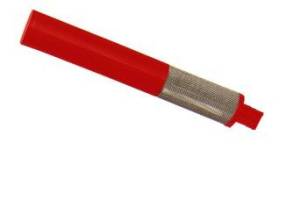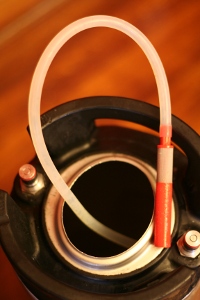Happy International Beer Day! I just finished celebrating by brewing ten gallons of smoked stout, and I’m looking forward to a draught of blonde ale from my kegerator later today. I’ve been homebrewing for about two years, and it’s a fun, practical hobby. Variety is the name of the game, both in terms of beer styles to produce but also in terms of the methods used to produce beer: extract, partial mash, all grain, single infusion, decoction, boil-in-a-bag, 1 gallon, 5 gallons, 10 gallons — you get the idea. The hobby facilitates the purchase of a tremendous amount of equipment for each of these different methods. The latest addition to my zymurgy hobby is the cask widge.
Like most homebrewers, I started out bottling the beer I produced. While this makes it easy to share my work with friends and colleagues, I find it to be a tedious, time consuming process. When I bought my first keg, I swore I’d never bottle beer again! Kegging is so much easier, so much faster, than bottling. But it’s not without its problems.
I’m not a particularly cautious brewer — I’m in it for the product, not the process — so many of my brews end up with a fair bit of sediment in them. Even after racking to a secondary, many of my beers have had a noticeable amount of sludge at the bottom. This sludge winds up being the entirety of the first glass or two I dispense from a keg.
This is because kegs have a dip tube that runs down the length of the keg, pulling beer from the bottom up into your glass. The first pull or two will grab any sludge that’s fallen to the bottom, and after that the beer should be clean and delicious. Some homebrewers avoid this problem by cutting their dip tubes an inch or so shorter than normal so that they sit above the sludge.

The cask widge, on the other hand, floats at the top of your beer, ensuring that your first pull is clean and refreshing! It attaches to a length of flexible tubing, and allows the widge to always rest at the top of the beer in your keg regardless of how much is left. It also includes a fine filter to ensure that any flotsam in your beer doesn’t make it into your glass.
The only kink with using a cask widge is that you need to get a gas length dip tube for your keg. You replace your normal dip tube with the gas length dip tube, connect the flexible tubing, and finally connect the cask widge. Fill and pressurize your keg as normal, and you’re all set!
In order to really test the cask widge, I intentionally brewed a “messy” beer, and ensured that a lot of trub was transferred from the brew kettle into the primary fermentation bucket. I skipped the secondary fermentation process altogether. When I filled the keg, I made sure to get a good bit of the sludge from the bottom of the bucket into the keg.
Despite my efforts to cause problems, the cask widge did what it was supposed to do. The beer I dispensed was clean and clear from the first glass to the last! All the rubbish I had intentionally transferred into the keg remained at the bottom, and was not pulled up by the widge.
Another use of the cask widge would be to use a corny keg as a secondary fermentation vessel, and use the cask widge to ensure that only the good clean beer gets transferred from that secondary into your serving keg. I haven’t tried this yet, but it’s definitely something I intend to try.
If you’re a really good brewer who carefully filters your beer and makes clean, sludge-free beer then you likely don’t need the cask widge. If you’re a brewer like me, the cask widge helps ensure that your beer looks its best at all times!
UK Brewing is currently the only US distributor of the cask widge that I’ve found. Feel free to share in the comments if you find another source.
I found out about the cask widge via Homebrew Finds, and I strongly encourage all homebrewers to follow that site (or associated Twitter account). Many thanks to Anthony at Buckeye Beverage Service for getting me the gas length dip tube I needed so quickly. If you’re a homebrewer in central Ohio, you should talk to Anthony.
Product Page: Cask Widge
